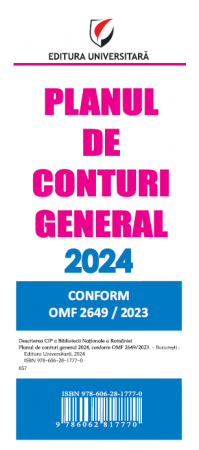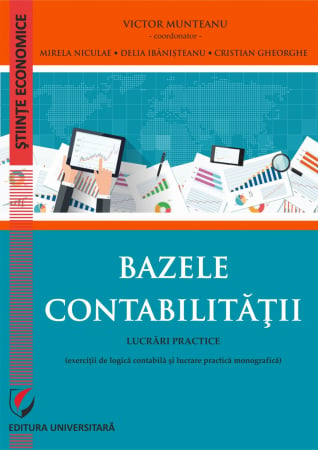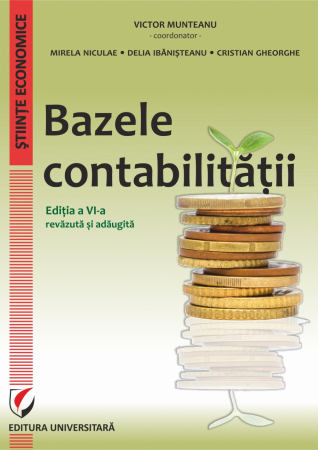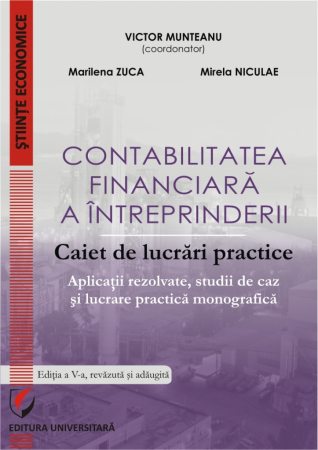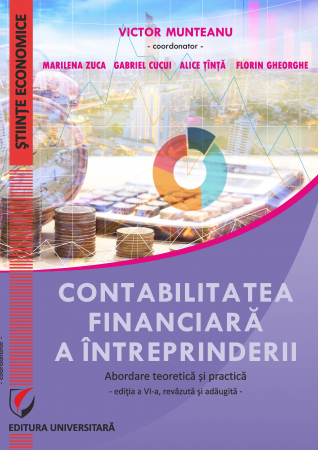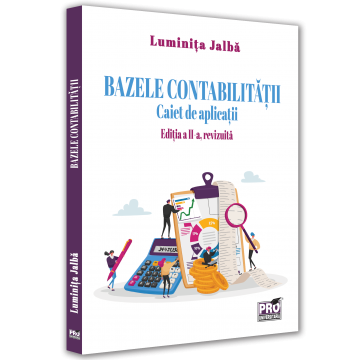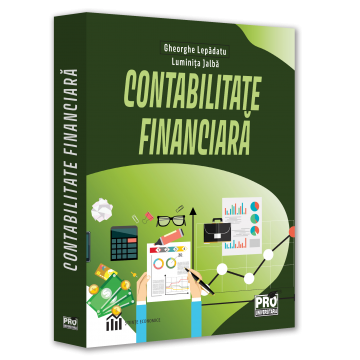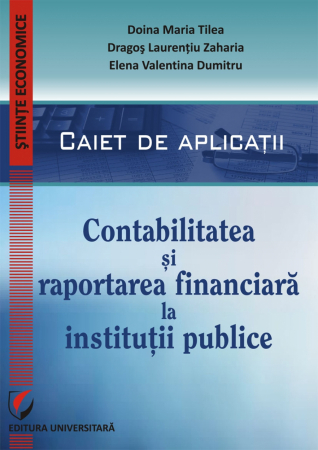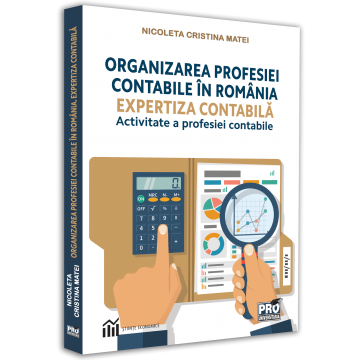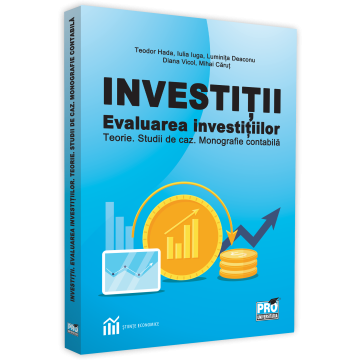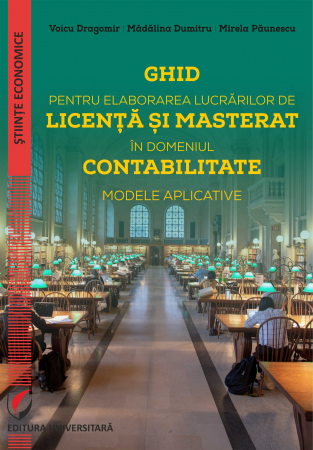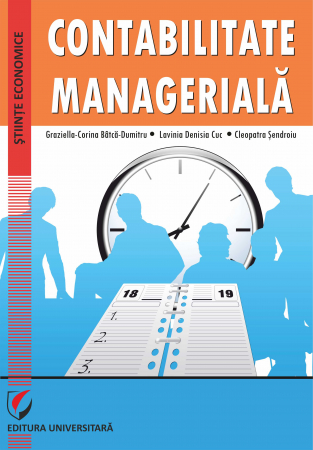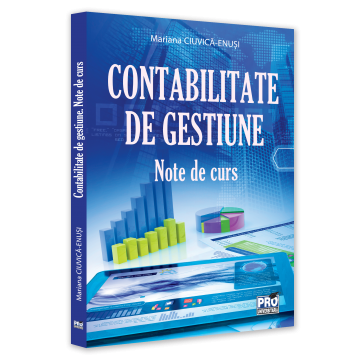6359.png) Accounting. From Theory to Practice. Method and Modeling/Accounting cycle and closing of the financial exercise, Vth edition, added and revised
Accounting. From Theory to Practice. Method and Modeling/Accounting cycle and closing of the financial exercise, Vth edition, added and revised
6359.png)
ISBN: 978-606-28-1420-5/978-606-28-1421-2
DOI: 10.5682/9786062814205, 10.5682/9786062814212
Publisher year: 2022
Edition: V, revised and added
Pages: 712
Publisher: Editura Universitară
Author: Traian-Ovidiu Calota
- Description
- Download (1)
- Authors
- Content
- More details
- Reviews (0)
Therefore, it can be said that, by detailing in the manner described above the issue of accounting, starting with its role and place in the organization and management of economic activities, working method, highlighting and reporting the status of an economic entity, this new edition is An important tool, available to all those interested in learning and specializing in this field. At the same time, the book is accessible and useful to managers at all hierarchical levels as it provides them with the theoretical and practical basis necessary for the efficient organization and management of economic activities.
Last but not least, in the book were inserted a series of important aspects that contribute to highlighting the scientific character of accounting, as well as to creating premises for further improvement of accounting as an information system and, implicitly, as a science. In this sense, the general issue of economic theories and mechanisms was addressed, but also the one regarding the establishment and organization of companies, the relationship within them, the relationship between accounting and taxation and management, as well as the impact of managerial decisions on the result.
Finally, we appreciate that this new edition offers the reader an overview of the major role of accounting in initiating and conducting economic and financial transactions.
*
The work “Accounting. From theory to practice. The accounting cycle and the closing of the financial year” aims to complete the area described in“ Accounting. From theory to practice. Method and modeling ”by detailing in a form accessible to beginners, but also useful to practitioners, the main aspects related to the analysis and operation of accounts, the accounting cycle, the closing works of the exercise, as well as the interconnection with taxation (VAT mechanism, profit taxation and income of micro-enterprises, taxation of dividends, etc.). The paper concludes with an accounting monograph which is an important tool for users to master specific accounting techniques.
In this volume we continued to apply the method of systematization, algorithmization and presentation, in schematic form, of complex issues, thus achieving not only a condensation of content but especially the efficiency of understanding and implicit learning.
The presented arguments recommend this paper to all those who want to study accounting in the broader context of economic training but also to those who need some details necessary to deepen their knowledge and improve their practice in the field.
An important element of originality is the interactive character of the practical applications, in the sense that the reader is invited to complete some parts of the analysis and the accounting formula with the concrete data that are found in the statement of the problem. Based on direct observations and pertinent suggestions made by my students, the 5th edition brings substantial changes in the introduction of communication exercises, a complex study related to the taxation of income obtained by micro-enterprises, and the improvement of the accounting monograph.
All this we hope to include the work "Accounting. From theory to practice. The accounting cycle and the closing of the financial year” in the general efforts of the specialists in the field, in order to make available to the users the most effective learning and working tools.
-
Accounting. From Theory to Practice. Method and Modeling/Accounting cycle and closing of the financial exercise, Vth edition, added and revised
Download
Doctor in economics, specialization Accounting, with the topic Accounting information in the management of tourism activity, Scientific leader; univ. prof. Dr. Ladislau Possler.
Postdoctoral fellowship at the Institute of World Economics of the Romanian Academy. Theme: Deepening regarding the directions of action for the efficient exploitation of the accounting and fiscal information in the management of the Romanian tourism. Tutor: Scientific researcher gr. I dr. Napoleon Pop and Expert of scientific research: prof. Univ. Dr. Cicilia Ionescu.
Teaching staff at Titu Maiorescu University, Faculty of Finance-Banking, Accounting and Business Administration, since 1999.
Accounting expert, CECCAR member, since 2003.
Tax consultant, CCFR member, since 2007.
Economic director of the tax consulting company Omega Consulting & Management
FOREWORD / 10
CHAPTER 1. THE ROLE AND PLACE OF ACCOUNTING IN THE ORGANIZATION AND CONDUCT OF ECONOMIC ACTIVITIES / 11
1.1. General considerations / 11
1.2. Object and terminological specifications / 16
1.3. Accounting functions / 24
1.4. Accounting principles / 25
1.5. Accounting method / 32
1.6. Accounting structure, organization and management / 37
CHAPTER 2. HIGHLIGHTING AND REPORTING THE STATUS OF AN ECONOMIC ENTITY / 41
2.1. General aspects regarding the accounting regulations applicable in Romania / 42
2.2. General aspects regarding the annual financial statements of the entities that apply Order 1802/2014 / 45
2.2.1. What is meant by the financial year? / 45
2.2.2. How are reporting entities classified? / 46
2.2.3. What is the type of reporting by entity category? / 48
2.2.4. Who prepares and signs the annual financial statements? / 51
2.2.5. What is the deadline for preparation and submission? / 51
2.2.6. Are companies required to publish financial statements? / 53
2.2.7. Who are the users of the annual financial statements? / 53
2.2.8. What is the usefulness of accounting information in the annual financial statements from a management perspective? / 54
2.2.9. Communication exercises / 56
2.3. Balance sheet / 57
2.3.1. Definition, form and structure / 57
2.3.2. The role and structure of heritage elements / 63
2.3.2.1. Asset / 63
2.3.2.2. Liabilities / 76
2.3.2.3. Communication exercises / 87
2.3.3. Impact of operations on assets / 99
2.3.3.1. Analysis of balance sheet changes in terms of the effect of economic and financial operations on the ratio Assets = Liabilities / 99
2.3.3.2. Analysis of balance sheet changes in terms of the effect of economic and financial operations on the ratio: A - D = C / 105
2.3.3.3. Communication exercises / 109
2.4. Profit and loss account (income statement) / 111
2.4.1. Profit and loss account - instrument for measuring and reporting the performance of the economic entity / 111
2.4.2. Profit and loss account structure and format / 112
2.4.2.1. Recognition of current expenditure / 114
2.4.2.2. Recognition of current income / 120
2.4.2.3. Current expenses and income versus expenses and income recorded in advance / 129
2.4.2.4. Structuring current expenditures / 132
2.4.2.5. Structuring current revenues / 133
2.4.2.6. Income statement format / 134
2.4.2.7. Communication exercises / 138
2.5. Statement of changes in equity / 142
2.6. Cash flow statement / 144
2.6.1. Generalities / 144
2.6.2. Classifications of accounting regulations / 144
2.6.3. Direct method case study / 154
2.6.4. Cash flow statement model by direct method / 156
2.6.5. Communication exercises / 160
2.7. Explanatory notes to the annual financial statements / 164
CHAPTER 3. THE SYSTEM OF ACCOUNTS / 165
3.1. Accounting account / 165
3.1.1. Account definition and configuration / 165
3.1.2. Rules of operation of accounts / 172
3.1.3. Single and double recording / 174
3.1.3.1. Simple registration / 174
3.1.3.2. Double registration / 175
3.2. Accounting analysis of economic and financial operations. Accounting formula. Accounting article / 176
3.2.1. Accounting analysis and configuration of the accounting formula / 177
3.2.2. Classification of the accounting formula / 178
3.2.2.1. Simple accounting formula / 179
3.2.2.2. Compound accounting formula / 179
3.2.2.3. Current accounting formula / 181
3.2.2.4. Reversal accounting formula / 181
3.2.2.5. Case study / 183
3.3. Classification of accounts / 187
3.4. Communication exercises / 189
3.5. General chart of accounts / 196
3.5.1. Treasury accounts / 197
3.5.2. Inventory accounts / 199
3.5.3. Fixed assets accounts / 202
3.5.4. Accounts receivable / 209
3.5.5. Debt accounts / 210
3.5.6. Expenditure accounts / 214
3.5.7. Income accounts / 215
3.5.8. Capital accounts / 216
3.5.9. Grid tests / 219
3.5.10. Communication exercises / 225
3.6. Check balance / 244
3.6.1. Definition and functions / 244
3.6.2. Classification / 244
3.6.3. Preparation methodology / 247
3.6.4. Exemplification of the preparation / 248
3.6.5. Case study / 254
3.6.6. Communication exercises / 279
3.6.7. Exercises proposed for solving / 282
CHAPTER 4. FINANCIAL DOCUMENTS ‑ ACCOUNTING / 285
4.1. Defining. Functions and classification / 285
4.2. Supporting documents / 287
4.3. Accounting records / 288
4.4. Case studies / 292
4.5. Communication exercises / 314
CHAPTER 5. VALUATION IN ACCOUNTING / 318
5.1. Principles of evaluation / 318
5.2. Elements of valuation technique in accounting / 319
5.2.1. Entry evaluation / 321
5.2.2. Output evaluation / 324
5.2.3. Cost estimation techniques / 336
5.3. Exercises proposed for solving / 40
BIBLOGRAPHY / 343
LIST OF FIGURES / 345
Annex 1 GENERAL ACCOUNT PLAN / 346
*
INTRODUCTION / 9
THANKS / 10
CHAPTER 1. ACCOUNT ANALYSIS AND FUNCTIONING / 11
1.1. Capital accounts / 11
1.1.1. Scheme of analysis and operation / 12
1.1.2. Example / 13
1.1.3. Communication exercises / 19
1.2. Fixed assets accounts / 24
1.2.1. Scheme of analysis and operation / 24
1.2.2. Example / 26
1.2.3. Communication exercises / 35
1.3. Accounts of stocks, debts and trade receivables / 42
1.3.1. Analysis of VAT accounts, debts and trade receivables / 43
1.3.2. Case study for non-VAT payers / 45
1.3.3. The VAT mechanism in the classical system / 54
1.3.4. Accounting VAT / 58
1.3.5. Case study for classic VAT payers (on invoicing) / 63
1.3.6. Case study for VAT payers on collection / 69
1.3.7. Complex case study / 77
1.3.7.1. Variant 1: VAT in normal regime (VAT on invoicing) / 78
1.3.7.2. Option 2: The company pays VAT on collection / 81
1.3.7.3. Option 3: The company practices VAT on invoicing and the partners apply VAT on collection / 84
1.3.8. Communication exercises / 87
1.4. Other third party accounts and debts / 94
1.4.1. Salary and social debt accounts / 95
1.4.1.1. Scheme of analysis and operation / 96
1.4.1.2. Example / 98
1.4.1.3. Communication exercises / 104
1.4.2. Accounts of various debtors and creditors / 107
1.4.2.1. Scheme of analysis and operation / 107
1.4.2.2. Example / 108
1.5. Treasury accounts / 111
1.5.1. Scheme of analysis and operation / 112
1.5.2. Example / 113
1.5.3. Communication exercises / 118
1.6. Expenditure accounts / 122
1.7. Income accounts / 123
1.7.1. Profit tax payer case study / 125
1.7.1.1. Profit tax calculation / 125
1.7.1.2. Profit sharing operations / 139
1.7.2. Case study paying micro-enterprises income tax / 141
1.7.2.1. Methodology for determining the tax / 142
1.7.2.2. Case study / 146
1.7.3. Exercises proposed for solving / 166
1.8. Special accounts / 170
1.9. Management accounts / 170
CHAPTER 2. ACCOUNTING CYCLE / 171
2.1. Legal specifications regarding the organization of accounting / 171
2.2. Operating cycle / 172
2.3. Financial and accounting documents / 175
2.4. Forms of registration for taxpayers who conduct double entry accounting / 176
CHAPTER 3. CLOSURE OF THE FINANCIAL YEAR / 182
3.1. Inventory of patrimony / 184
3.1.1. Recital general / 184
3.1.2. Pre and post inventory activities / 185
3.1.3. Succession of inventory activities / 185
3.1.4. Inventory methodology / 186
3.1.5. Valuation of inventoried assets and liabilities / 191
3.1.6. Case study on updating receivables, debts and cash in foreign currency / 193
3.1.7. Case study on the establishment and resumption of adjustments for impairment of receivables / 199
3.1.8. Case study on the establishment and resumption of provisions for future risks / 202
3.2. Preparation and presentation of the balance sheet / 204
3.3. Preparation and presentation of the income statement / 216
3.4. Milestones regarding the analysis of the annual financial statements / 225
CHAPTER 4. ACCOUNTING MONOGRAPH / 236
4.1. Presentation of transactions and events in the year of establishment / 236
4.2. Presentation and registration of accounting documents / 241
4.3. Presentation of the journal register / 272
4.4. Presentation to complete the statement of accounts / 274
4.5. Preparation of the verification balance / 279
4.6. Monograph Annexes / 281
4.6.1. Sales and purchase journals / 281
4.6.2. Tax returns / 282
4.6.2.1. Declaration 100/282
4.6.2.2. Declaration 112/284
4.6.2.3. Statement 300 VAT / 296
4.6.2.4. Information return 394 VAT / 301
4.7. Inventory / 308
4.7.1. Inventory decision / 308
4.7.2. Management statements / 309
4.7.3. Property, plant and equipment inventory list / 311
4.7.4. Account Extras / 311
4.7.5. Inventory report / 312
4.8. Annual financial statements / 318
4.8.1. Abbreviated balance sheet / 318
4.8.2. Abbreviated profit and loss account / 321
4.8.3. Explanatory notes to the annual financial statements / 322
4.9. Presentation of transactions and events from the first month of the following year / 332
BIBLIOGRAPHY / 338
LIST OF FIGURES / 341
Annex 1. GENERAL ACCOUNT PLAN ACCORDING TO OMFP 1802/2014 / 342

![Accounting. From Theory to Practice. Method and Modeling/Accounting cycle and closing of the financial exercise, Vth edition, added and revised [1] Accounting. From Theory to Practice. Method and Modeling/Accounting cycle and closing of the financial exercise, Vth edition, added and revised [1]](https://gomagcdn.ro/domains/editurauniversitara.ro/files/product/large/contabilitate-ed-5-6453-6296.jpg)
